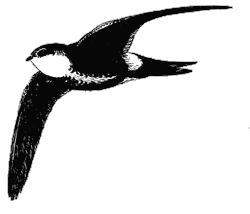White-throated Swift

No other birds in the world are so purely creatures of the air as are the swifts. Small birds with short tails and saber-shaped wings, they speed through the sky in search of flying insects. Their small feet are not designed for perching in normal bird fashion; they can only cling to vertical surfaces, so they land only when necessary. Their nests are made primarily of their own saliva, which hardens to a substance resembling shellac (the nests of some Asian species, which separate into gelatinous shreds when soaked and cooked, are the source of bird’s nest soup). Except during the season when they are raising young, or during very bad weather, swifts may spend all their waking hours in flight. Some European swifts are even thought to sleep in the air.
The only member of the family normally seen over the southwestern U.S. lowlands is the white-throated swift. Little colonies nest in crevices in the rocks of cliffs and canyons, but flocks may be seen anywhere over the desert. Sometimes they are almost too high to see, and only their high-pitched chattering gives them away; sometimes they course low over the ground. They are perhaps best seen along the rims of canyons, where they may go hurtling past at breathtaking speeds. Some people have suggested that white-throated swifts might exceed 200 miles per hour in level flight; although it would be hard to measure this, anyone who has seen them zoom past at close range will not find it hard to believe.
—Kenn KaufmanWhite-throated Swift (Aeronautes saxatalis)
Order: Apodiformes
Family: Apodidae
Spanish Names: vencejo, golondrina
Distinguishing Features
The White-throated Swift has long, narrow, stiff wings; their black and white pattern distinguishes this species from other North American swifts.
Habitat
The White-throated Swift roosts and nests in the crevices of cliff faces. It forages over all desert habitats in open sky.
Life History
Swifts spend most of their time in the air, foraging for flying insects. Eating, drinking, bathing, even courtship and copulation take place in the air; during mating the pair tumbles downward, sometimes for over 500 feet (250 m). Nests are built in crevices of cliffs; they are made of grass and feathers glued together with saliva. The same nest sites may be used year after year by a colony of these social birds.
Although the family name means “without feet,” swifts do have feet—unusual ones, in which the 4 toes point forward. This, and the exceptionally long claws, are thought to be adaptations to clinging to vertical surfaces, such as cliff faces or nests. The legs of swifts are small and weak, as suits an animal that so rarely touches down. White-throated Swifts may be the fastest flying North American birds. Both nestling and adult White-throated Swifts can become torpid during cool weather or food shortages.
Born to Fly
Aerodynamically, flight is the triumph of lift and propulsion over gravity and drag. In flapping flight the outer wing feathers (primaries) produce the propulsion, and the inner wing feathers (secondaries) produce the lift. Lift is generated by air moving over an air foil, or wing. In addition to flapping flight, birds also glide and soar. In gliding flight, birds gradually lose altitude on steady out-stretched wings. In soaring flight, birds gain altitude on steady out- stretched wings by riding updrafts of air.
The demands and advantages of flight have produced some dramatic adaptations in birds. One of these adaptations centers around weight reduction.
Weight Reducing Adaptations in Birds:
-
• Some large bones are thin and hollow
• Some bones are fused or reduced in size, e.g. the bones of the front limb and tail
• Feathers provide light strength
• Few skin glands
• No teeth or heavy jaws
• Air sacs
• Ovipary not vivipary (they lay one egg at a time)
• Atrophy of reproductive organs between breeding seasons
• Usually only one ovary
• Generally select high calorie, compact foods (such as seeds and insects)
• Rapid and efficient digestion
• No bladder; they excrete a dry, light-weight uric acid










